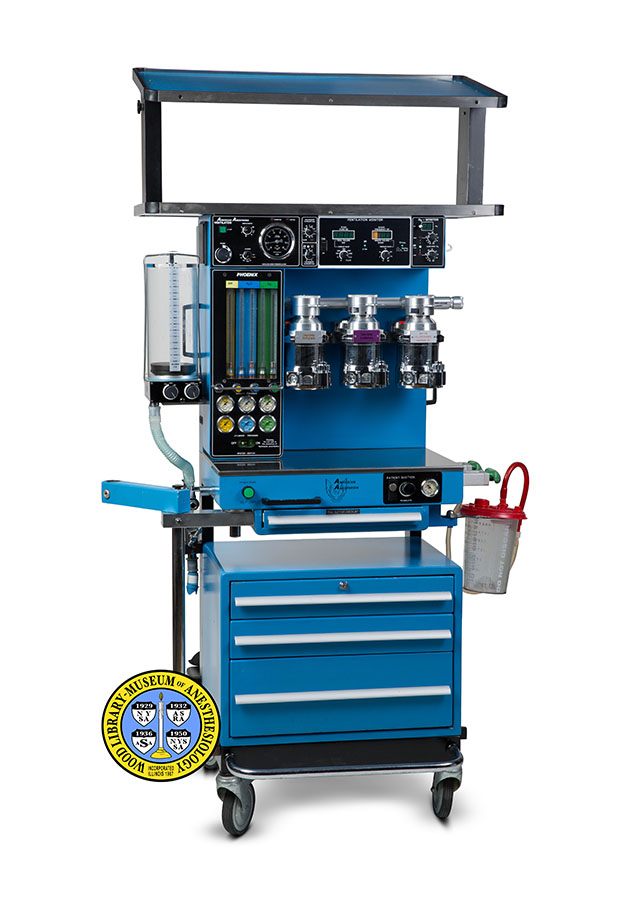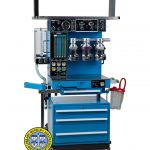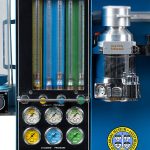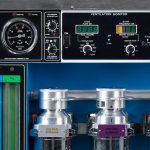Phoenix Anesthesia Machine
The Phoenix machine was designed by Mr. John C. Lundy, the son of pioneering anesthesiologist John S. Lundy, M.D. (1894-1973). It was manufactured in Bad Ems, Germany (then West Germany) in 1985. It was sold by American Anesthesia, Inc., which had been founded by Mr. Lundy in Orange, California the previous year. Competing against major corporations such as Draeger and Ohmeda, the company sold fewer than 100 anesthesia machines through the late 1990s. The machine shown here was in use throughout that time.
It appears that the ventilator provided one mode of ventilation: volume control. The ventilator and an oxygen concentration monitor provided the following adjustable alarms: high pressure, low pressure, minute volume, high oxygen concentration and low oxygen concentration. In addition to the gases nitrous oxide and oxygen, the machine could administer liquid anesthetic from any of its three vaporizers: an Enfluratec, an Isotec 3 or a Fluotec 3. All three were made by Cyprane, a company founded in Great Britain. These vaporized enflurane (Ethrane), isoflurane (Forane) and halothane (Fluothane), respectively.
Catalog Record: Phoenix Anesthesia Machine
Access Key: amsg
Accession No.: 2008-08-07-1
Title: Phoenix [anesthesia machine] / American Anesthesia.
Corporate Author: American Anesthesia, Inc.
Publisher: Bad Ems, West Germany : Anesthesia for American Anesthesia Inc., 1985.
Physical Descript: 1 anesthesia machine : metals, plastics, glass ; 179 x 96 x 77 cm.
Subject: Anesthesia Machines.
Subject: Anesthesia, Inhalation – instrumentation.
Note Type: General
Notes: The title is based on text found on the front of the machine. There is also
an image of a phoenix on te front of the machine. A descriptive qualifier was
added by the cataloger to clarify object for catalog users.
Note Type: Exhibition
Notes: According to John C. Lundy, former owner of American Anesthesia, Inc., the
“85” in the serial number of the machine indicates the year that this machine
was manufactured.
Note Type: Citation
Notes: Email communications. Accession record 2008-08-07-1. Archives. Located at:
Located at: Wood Library-Museum of Anesthesiology, Schaumburg, Illinois.
Note Type: Physical Description
Notes: [1] One cabinet style anesthesia machine; The machine is medium blue and sits
on four wheels; Beginning at the top, there are two shelves; The upper most
shelf is angled forward approximately 10 to 15 degrees; The second shelf is
flat; Below the second shelf on the upper left is a green “ON/OFF” button for
the ventilator; The text, “AMERICAN ANESTHESIA [new line] VENTILATOR” is
located just above the ON/OFF button; Below the ON/OFF button is a dial for
volume; The pointer on the dial can be turned to any point along a graphic
around the volume dial; This graphic is a curved line of white and black
rectangles that is wide on one end and narrow on the other; A dial for
respiratory rate and a dial for I:E ratio are located to the right of the
ON/OFF button and volume dial; The upper respiratory rate control is marked,
“BREATH/MINUTE” and the dial pointer can be turned along a solid white scale
that is numbered at the following points: 6, 8, 10, 15, 20, 25, 60; Below
this is the control for I:E ratio; It is marked “I:E RATIO” and the dial
pointer can be turned along a white and red scale that is numbered at the
following locations: 1:4, 1:3, 1:2, 1:1,5, 1:1, 1,5:1, and 2:1; To the right
of these dials is a pressure gauge marked in increments of one “mbar”; The
increments are numbered at the following points: -10, 0, 10, 20, 30, 40, 50,
and 60; The following markings are also on the face of the gauge: “STEPHAN”,
“Beatmungsdruck”, and “WIKA”; The following is marked below the pressure
gauge, “VENTILATOR AIRWAY PRESSURE cm/H2O”; Two small red light bulbs are
located above the pressure gauge; They are marked “POWER FAIL” and “FAN
FAIL”; To the right of the gauge are two alarm controls outlined in an upper
and lower rectangular area; The upper area contains a dial that is surrounded
by a solid scale that is numbered at the following increments: 5, 10, 15, 20,
25, 30, 35, 40, 45, 50, 55, and 60; The following markings are located above
this dial, “HIGH PRESSURE ALARMLIMIT/mbar”; Below this dial is a small red
bulb that is marked, “ALARM”; The lower alarm area contains a dial with a
solid white scale that is marked at the following points, “2.5, 5, 10, 15, 20
25, 30; Above this dial is a small white light bulb with a white button that
is marked with a symbol for silencing an alarm and the text, “1 min”; Below
this dial is the following text, “LOW PRESSURE [new line] ALARMLIMIT/mbar”;
To the right of these two alarm controls is a rectangular area marked,
“VENTILATION MONITOR”; On the far right of this area is a switch marked “ON”
at one end and “OFF” at the other end; To the right of this is a digital
display for up to four numbers; Above the display is, “(l/min) [new line]
FLOW OR”; Below the display is marked, “TIDAL VOLUME [new line] (ml) [new
line] minimum level”; Below this is a dial marked “FLOW”; It is surrounded by
a solid white scale and numbered at the following points: 0, 50, 100, 200,
300, 400, 600, and 800; Between this digital display and another to the right
is a small blue button marked with a symbol for a silenced alarm and the text
“2 min”; The second digital display has space for three numbers; The first
number area is colored orange; Above the digital display is “(b/min) [new
line] FREQUENCY OR”; Below the display is “MINUTE VOLUME [new line] (l/min)
[new line] minimum level”; Below these is a dial surrounded by a solid white
scale that is marked at the following points: 0, 5, 10, 15, 20, 25 and 30; To
the right of this is a light blue button with, “V/freq.” marked above it and
“fleeting [new line] fixed” marked below”; To the right of this is a
rectangular area marked, “O2 – MONITOR”; A digital display for up to two
numbers has a dial marked, “Cal.” on the left and, “%O2” on the right; Dials
to set an alarm for a “HIGH” %O2 limit and a “LOW” %O2 limit each have a
small red light bulb to the left … [continued at 2].
Note Type: Physical Description
Notes: [2, continued from 1] Between the two bulbs is a white button with a symbol
for a muted alarm and “1 min” marked to the left; Below the ventilator
controls, on the left is a flowmeter bank for AIR, N2O and O2; Air has a
single flowmeter while N2O and O2 have both coarse and fine flow tubes;
Marked at the top of the bank is, “PHOENIX”; Below the tubes each gas has a
pipeline pressure gauge and a cylinder pressure gauge; An ON OFF switch below
the pressure gauges is marked, “MASTER SWITCH”; To the right of the flowmeter
bank are three vaporizers manufactured by Cyprane: Enfluratec 3, Isotec 3,
and a Fluotec 3; A horizontal bar behind the vaporizers turns to indicate
which vaporizer is open to the breathing system; The markings on this bar are
for “OFF”, “ENFLURANE”, “ISOFLURANE” AND “HALOTHANE”; Just below the table
top, on the left, is a green push button marked, “PUSH FOR” above the button
and, “O2 FLUSH” below the button; Also centered just below the table top is
an image of a Phoenix with the following text superimposed over it, “AMERICAN
ANESTHESIA”; On the right just below the table top is a dial and gauge marked
“PATIENT SUCTION”; Below these is a pull-out shelf with a checklist adhered
to the top; A space and then three drawers are located below the pull-out
shelf; A bar extends from the front of the machine, just below the drawers,
perhaps to move the machine with one’s feet?; The ventilator bellows is
located on the left side of the machine; It is marked in increments of 50
“ccm” from 0 to 1500 and numbered at 0, 100, 200, 300, 400, 500, 600, 700,
800, 900, 1000, 1100, 1200, 1300, 1400, and 1500; The following is marked at
the base of the increments, “VOLUMEN [new line] ccm”; Two dials are located
below the bellows; On the left is a dial for PEEP; The dial is surrounded by
a solid white scale that is wide at one end and narrow at the other end; The
dial on the right is marked “PEAK PRESSURE”; This dial is also surrounded by
a solid white scale that is wide at one end and narrow at the other end; A
port marked, “COMMON OUTLET” extends from the left side of the table top; At
about the table top level is an arm extension for supporting breathing system
components, which are not set up; Some breathing system components are
located in the drawers; Also on the left side of the machine is a handle for
moving the machine, a port marked, “AIRWAY PRESSURE TUBING”, a port marked,
“OXYGEN SENSOR”, a port marked, “FLOW SENSOR” and some of the components for
a gas scavenger; On the right side of the machine is a support for a suction
canister and tubing, and two yokes for O2 canisters; These yokes have green
handles; An electric cord is located on the back of the machine, as are six
sockets for monitoring and accessory equipment; A yoke for N2O with a blue
handle is on the left side of the back and a yoke for air with a yellow
handle is on the right; Also on the back are ports labeled “O2”, “O2 [new
line] POWER OFF”, “N2O”, “AIR”, and “VAC”; A manufacturer label is fixed to
the back at about table top level; It is marked with the following:
“Manufactured by [an image of two lungs and the trachea, a logo?] anesthesia
[new line] Bad Ems West Germany [new line] for AMERICAN ANESTHESIA Inc. [new
line] Protecting class I B Power consumption 85 VA [new line] Voltage 115V /
60Hz [new line] Type Phoenix [new line] Serial no. 1376 – 85 – 142″; Also on
the back are 9 maintenance stickers for “LUNDY MEDICAL SUPPLY, INC.”; These
stickers are also marked with, “MAINTENANCE AGREEMENT INSPECTIONS [new line]
Inspected and Serviced By:”; There is one service sticker from “SCV
Biomedical Services”, also marked with “(800) 624-7982 [new line] PREVENTIVE
MAINTENANCE”.
Note Type: Reproduction
Notes: Photographed by Mr. Steve Donisch, June 8, 2015.
Note Type: Historical
Notes: This Phoenix anesthesia machine, sold by American Anesthesia Inc., was
manufactured in Bad Ems, Germany (then West Germany) in 1985. American
Anesthesia Inc. was incorporated in Orange, California in 1984 by Mr. John C.
Lundy. Mr. Lundy is the son of pioneering anesthesiologist John S. Lundy
(1894-1973). Through American Anesthesia Inc., Mr. Lundy designed and sold 95
anesthesia machines from about 1984 to the late 1990s. Mr. Lundy also founded
Lundy Medical Supply, Inc. in 1979. In addition to distributing medical
supplies, Lundy Medical Supply maintained and repaired anesthesia machines.
The service stickers on the back of this machine indicate that it was used
into the late 1990s. It appears that the ventilator provided one mode of
ventilation: volume control. The ventilator and an oxygen concentration
monitor provided the following adjustable alarms: high pressure, low pressure
minute volume, high oxygen concentration and low oxygen concentration. The
vaporizers were made by Cyprane, a company founded in Great Britain, and
include an Enfluratec 3, Isotec 3 and a Fluotec 3.
Note Type: Exhibition
Notes: Selected for the WLM website (noted November 3, 2015).




